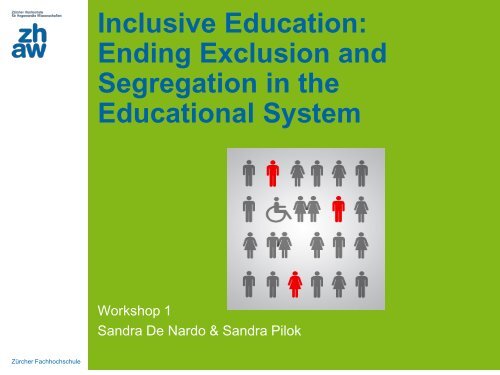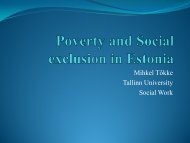Inclusive Education: Ending Exclusion and ... - social-europe
Inclusive Education: Ending Exclusion and ... - social-europe
Inclusive Education: Ending Exclusion and ... - social-europe
Create successful ePaper yourself
Turn your PDF publications into a flip-book with our unique Google optimized e-Paper software.
Zürcher Fachhochschule<br />
<strong>Inclusive</strong> <strong>Education</strong>:<br />
<strong>Ending</strong> <strong>Exclusion</strong> <strong>and</strong><br />
Segregation in the<br />
<strong>Education</strong>al System<br />
Workshop 1<br />
S<strong>and</strong>ra De Nardo & S<strong>and</strong>ra Pilok
School system CH<br />
• Preschool<br />
• Primary school<br />
Zürcher Fachhochschule<br />
What is the present situation in the<br />
Swiss school system<br />
• Secondary School (Sek I)<br />
• High school, specialized middle<br />
school, professional school (Sek II)<br />
• Orthopedagogy<br />
• University, Paeagogy highsschool,<br />
college of higher education,<br />
higher professional school<br />
• further education
Zürcher Fachhochschule<br />
Example: where do children with a<br />
physical h<strong>and</strong>icap receive their<br />
education?<br />
Special educational concepts for canton BL<br />
<strong>and</strong> BS<br />
Students with disabilities are<br />
entitled to receive assistants<br />
adapted to their needs in<br />
education <strong>and</strong> vocational<br />
training.<br />
The placement criterias for<br />
students with disabilities are<br />
adapted to their needs,<br />
taking into account welfare<br />
<strong>and</strong> development<br />
opportunities, as well as<br />
school environment <strong>and</strong><br />
administration.<br />
The special educational program promotes tailored<br />
education, personality development <strong>and</strong> school<br />
integration for students with special needs. As well<br />
as promoting independent living with a disability.<br />
(Kantonales Bildungsgesetz, § 4, 5a und § 47)
Zürcher Fachhochschule<br />
Which strategies, policies <strong>and</strong><br />
regulations exist in the EU regarding<br />
inclusive education<br />
•The tagline (motto) of the schools in Finl<strong>and</strong> is: "No<br />
one should remain behind at school". Including<br />
disabled children, they attend the same school with<br />
others. The Finnish school system is a success: Already<br />
three times, Finl<strong>and</strong> ended up in the PISA study in the<br />
first place.<br />
•The general question is, which school system is the<br />
best?
Zürcher Fachhochschule<br />
Is this strategy implemented anywhere<br />
else in the EU? Example in Germany<br />
Integrative Kindertagesstätte, St. Franziskus<br />
• In the kindergarten, 22 children with disabilities <strong>and</strong> 55 children without<br />
disabilities made up the group <strong>and</strong> the following areas where promoted:<br />
Integrative three groups, a special education group, an open group.<br />
• There is therapeutic support at the same place where the lessons take<br />
part<br />
• Occupational therapy, physiotherapy, speech therapy<br />
• Team <strong>and</strong> treatment (s)<br />
• Special educated teachers, occupational therapist, curative in, child<br />
care taker, educator / <strong>social</strong> worker <strong>and</strong> group management (training?).<br />
• The team is completed in the day care center by a practicing<br />
physical <strong>and</strong> speech therapist.
Zürcher Fachhochschule<br />
Tolerance rather than exclusion in St.<br />
Franziskus<br />
Tolerance rather than exclusion<br />
In addition to the targeted individual support the goal was to pursue an<br />
integrated approach for children with various conditions to know each<br />
other unconditionally <strong>and</strong> jointly through experiences. The cooperation<br />
is quickly perceived as "normal".<br />
The children learned on their own, their strengths, as well as the<br />
strengths <strong>and</strong> respecting the limits of other children.<br />
The children formed a community through common experiences,<br />
learning from each other <strong>and</strong> learning to respect each other.<br />
Acquiring <strong>social</strong> skills is the first step away from discriminating <strong>and</strong> be<br />
discriminated against due to disadvantages; resulting in equal<br />
participation in society.
Zürcher Fachhochschule<br />
Definition<br />
•Inclusion in education is an approach to educating students with special<br />
educational needs. Under the inclusion model, students with special needs<br />
spend most or all of their time with non-disabled students. Implementation<br />
of these practices varies. Schools most frequently use them for selected<br />
students with mild to severe special needs. [1]<br />
•<strong>Inclusive</strong> education differs from previously held notions of ‘integration’ <strong>and</strong><br />
‘mainstreaming’, which tended to be concerned principally with disability<br />
<strong>and</strong> ‘special educational needs’ <strong>and</strong> implied learners changing or becoming<br />
‘ready for’ or deserving of accommodation by the mainstream. By contrast,<br />
inclusion is about the child’s right to participate <strong>and</strong> the school’s duty to<br />
accept the child. Inclusion rejects the use of special schools or classrooms<br />
to separate students with disabilities from students without disabilities. A<br />
premium is placed upon full participation by students with disabilities <strong>and</strong><br />
upon respect for their <strong>social</strong>, civil, <strong>and</strong> educational rights.
Zürcher Fachhochschule<br />
<strong>Inclusive</strong> <strong>Education</strong>: Positive effects<br />
•positive effects for children with disabilities in areas<br />
such as reading individualized education program<br />
(IEP) goal, improving communication <strong>and</strong> <strong>social</strong> skills,<br />
increasing positive peer interactions, many<br />
educational outcomes, <strong>and</strong> post school adjustments.<br />
Positive effects on children without disabilities<br />
include the development of positive attitudes <strong>and</strong><br />
perceptions of persons with disabilities <strong>and</strong> the<br />
enhancement of <strong>social</strong> status with nondisabled peers
Zürcher Fachhochschule<br />
Which methods/instruments have<br />
proven to be successful in Switzerl<strong>and</strong>?<br />
Integrative <strong>Education</strong> (IF)<br />
• Pupils at primary schools in need of temporary special education may,<br />
under § 28 of the basic school rules will receive integrated advertising<br />
campaigns by special education teachers.<br />
Integrated advertising campaigns are a form of special education, the<br />
nature of these incentives is their involvement (integration) in the teaching<br />
of elementary school.<br />
Special education<br />
• Remedial teachers work as integrative teaching force at all levels of<br />
mainstream education <strong>and</strong> special education in schools. They cover the<br />
needs <strong>and</strong> strengths of children. As support, they develop support plans<br />
<strong>and</strong> implement them. They support the children so that they acquire the<br />
necessary knowledge <strong>and</strong> skills to achieve individual learning goals <strong>and</strong> to<br />
make everyday life as independently as possible.
Zürcher Fachhochschule<br />
Critics of inclusion<br />
•Critics of full <strong>and</strong> partial inclusion include both educators,<br />
administrators <strong>and</strong> parents. Full <strong>and</strong> partial inclusion<br />
approaches neglect to acknowledge the fact most students<br />
with significant special needs require individualized<br />
instruction or highly controlled environments. Thus, general<br />
education classroom teachers often are teaching a curriculum<br />
while the special education teacher is remediating instruction<br />
at the same time. Similarly, a child with serious inattention<br />
problems may be unable to focus in a classroom that contains<br />
twenty or more active children. Although with the increase of<br />
incidence of disabilities in the student population, this is a<br />
circumstance all teachers must contend with, <strong>and</strong> is not a<br />
direct result of inclusion as a concept
Zürcher Fachhochschule<br />
Myths <strong>and</strong> Reality<br />
• Separate is better<br />
• Segregation doesn't work. Whether children are separated based on race,<br />
ability, or any other characteristic, a separate education is not an equal<br />
education. Research shows that typical children <strong>and</strong> children with disabilities<br />
learn as much or more in inclusive classes.<br />
• Children must be "ready" to be included<br />
• All children have the right to be with other children with their own age. A<br />
child with disabilities does not have to perform at a certain grade level or act<br />
exactly like the other children in the class to benefit from being a full-time<br />
member in general education.<br />
• Parents do not support inclusive education<br />
• Parents have been <strong>and</strong> continue to be the driving force for inclusive<br />
education. The best outcomes occur when parents of children with disabilities<br />
<strong>and</strong> professionals work together. Effective partnerships happen when there is<br />
collaboration, communication <strong>and</strong>, most of all, TRUST between parents <strong>and</strong><br />
professionals.
Zürcher Fachhochschule<br />
The End<br />
•Thank you for your attention



